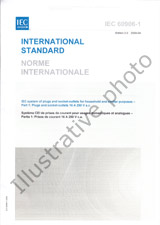We need your consent to use the individual data so that you can see information about your interests, among other things. Click "OK" to give your consent.

IEC 62980-ed.1.0
Parasitic communication protocol for radio-frequency wireless power transmission
Translate name
STANDARD published on 28.9.2022
The information about the standard:
Designation standards: IEC 62980-ed.1.0
Publication date standards: 28.9.2022
SKU: NS-1096214
The number of pages: 88
Approximate weight : 295 g (0.65 lbs)
Country: International technical standard
Category: Technical standards IEC
The category - similar standards:
Other equipment related to power transmission and distribution networks
Annotation of standard text IEC 62980-ed.1.0 :
IEC 62980:2022 defines procedures for transferring power to non-powered IoT devices using the existing ISM band communication infrastructure and RF WPT and a protocol for a two-way, long-distance wireless network in which IoT devices and APs communicate using backscatter modulation of ISM-band signals. Three components are required for two-way, long-distance wireless communication using backscatter modulation of ISM-band signals: • an STA that transmits wireless power and data packets to SSNs by forming ISM-band signal channels between HIE-APs, • a battery-free SSN that changes the sensitivity of the channel signals received from the STA using backscatter modulation, and • an HIE-AP that practically decodes the channel signals whose sensitivity was changed by the SSN. In this document, the procedures for CW-type RF WPT using communication among these three components are specified based on application of the CSI or RSSI detection method of ISM-band communication. This document proposes a convergence communication protocol than can deploy sensors, which can operate at low power (dozens of microwatts or less) without batteries, collect energy, and perform communication, to transmit power to SSNs using RF WPT based on parasitic communication. This method can be applied to application service areas such as domestic IoT, the micro-sensor industry, and industries related to environmental monitoring in the future. LIEC 62980:2022 definit les procedures de transfert denergie vers des dispositifs dIoT au moyen de linfrastructure de communication existante sur les bandes ISM et du WPT RF, ainsi quun protocole de reseau sans fil longue distance bidirectionnel qui permet aux dispositifs dIoT et aux points dacces de communiquer par modulation de retrodiffusion des signaux sur les bandes ISM. La communication sans fil longue distance bidirectionnelle fondee sur la modulation de retrodiffusion des signaux sur les bandes ISM exige trois elements: • une STA qui assure le transfert sans fil de lenergie et des paquets de donnees vers les SSN en creant des canaux de signaux dans les bandes ISM entre HIE-AP ; • un SSN sans batterie qui modifie, par modulation de retrodiffusion, la sensibilite des signaux de canal recus depuis la STA ; et • un HIE-AP qui decode de maniere pratique les signaux du canal dont la sensibilite a ete modifiee par le SSN. Dans le present document, les procedures de WPT RF de type CW qui utilisent la communication entre ces trois elements sont specifiees a partir de lapplication dune methode de detection des CSI ou du RSSI de la communication sur les bandes ISM. Le present document propose un protocole de communication convergent qui peut deployer des capteurs, lesquels peuvent fonctionner a faible puissance (quelques dizaines de microwatts ou moins) sans batteries, collecter de lenergie et assurer une communication, afin dalimenter des SSN au moyen dun WPT RF fonde sur une communication parasite. Cette methode pourra etre appliquee ulterieurement a des services dapplication tels que lIoT domestique, lindustrie des microcapteurs et les industries impliquees dans la surveillance de lenvironnement.
We recommend:
Technical standards updating
Do you want to make sure you use only the valid technical standards?
We can offer you a solution which will provide you a monthly overview concerning the updating of standards which you use.
Would you like to know more? Look at this page.



 Cookies
Cookies
